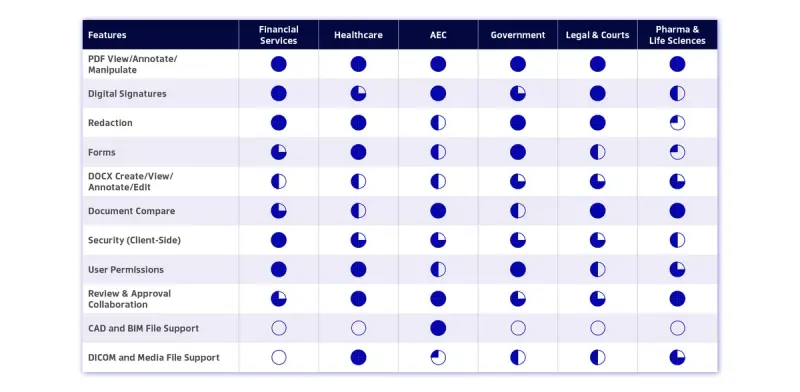Who is this guide for?
Are you considering incorporating document processing capabilities into your applications or workflows? Whether you're in the early stages of exploration or already deep in the buying process, our comprehensive SDK Buying Guide is here to assist you. Discover key insights, essential considerations, and valuable tips that will empower you to make an informed decision when selecting an SDK for document processing.
SDK BASICS
An SDK, or Software Development Kit, serves as a comprehensive package of APIs, libraries, code samples, and documentation for developers. It allows them to efficiently build applications for specific platforms or systems.
By leveraging an SDK developed and maintained by a specialized third party, you can save valuable time and resources in development, enhance product quality, and achieve seamless integration with related products and frameworks.
The key components of an SDK typically include APIs and libraries for frequently used code sequences, code samples for practical application, and comprehensive documentation offering step-by-step guides, pre-built sample apps, developer support, code walkthroughs, tutorial videos, and other technical materials.
By combining SDKs with your own code, you can create a robust software product without having to build and maintain every aspect from scratch. Ultimately, an SDK serves as a catalyst to accelerate software development projects, enabling faster time-to-market and long-term cost efficiency.
PDF SDKs serve as specialized software development kits designed to facilitate the rapid introduction of PDF-related functionality within applications. They empower developers to create, modify, and manage PDF documents effortlessly, opening a world of possibilities for businesses and individuals alike.
A document processing SDK typically supports a wide range of document formats, including text documents, spreadsheets, presentations, PDFs, images, and more. A document processing SDK enables developers to parse and extract data from documents, manipulate and modify document content, convert and export documents to different formats, generate and automate document creation, extract and analyze data from documents, apply security measures to protect documents, perform OCR (Optical Character Recognition) on scanned documents, and facilitate collaboration and commenting on documents.
An Office Document Processing SDK enables developers to programmatically interact with office documents, extract data, manipulate content, perform conversions, generate reports, and automate various tasks. It typically provides features tailored to specific office document formats, such as DOCX (Microsoft Word), XLSX (Microsoft Excel), PPTX (Microsoft PowerPoint), ODT (OpenDocument Text), ODS (OpenDocument Spreadsheet), and more.
A CAD Document Processing SDK enables developers to extract information, manipulate, convert, or perform other operations on CAD files programmatically. CAD document processing SDKs are designed to handle specific tasks related to CAD files, including: File Parsing and Extraction, Conversion and Export, Geometry and Attribute Manipulation, Visualization and Rendering, Data Extraction and Analysis, Collaboration and Markup
PDF SDK USE CASES
What is the value of a PDF SDK?

Improve efficiency and reduce expenses
Developing document-related technology entirely in-house can be financially prohibitive and operationally taxing. By turning to established PDF SDK vendors, developers can tap into existing, well-built technology that meets the demands of a mature market. This approach eliminates the need to reverse-engineer and build everything from scratch, freeing up valuable time and resources.
Differentiate your offering and improve productivity
With seamless PDF functionality integration, developers have the power to create applications that offer a wide range of features, providing users with a single solution to accomplish their tasks without the inconvenience of switching between multiple apps. This streamlined experience not only enhances user productivity but also contributes to their overall satisfaction, enabling them to maximize their time within a single application.

USE CASES

What can I use a PDF SDK for?
In today's digital age, efficient PDF processing is essential for companies across various industries. Whether you're a software company looking to integrate document processing into your application or a corporate business seeking to streamline your document workflows, PDF SDKs offer powerful solutions to integrate document processing capabilities into your applications.

PDF SDKs for Internal Workflows
Businesses in various industries can benefit from document SDKs to enhance their document workflows. Whether it's automating document creation, extracting critical information from PDFs, or securely managing digital signatures, PDF SDKs offer a wide range of features to optimize document-related processes. By integrating PDF SDKs into their existing systems, companies can streamline their document workflows, reduce manual efforts, and improve overall operational efficiency.

PDF SDKs for SaaS Applications
For software companies, integrating document processing capabilities into their applications can be a game-changer. PDF SDKs provide the necessary tools and libraries to empower software developers to incorporate robust PDF functionalities directly into their software solutions allowing them to get to market faster, increase time in app, differentiate from the competition and improve customer satisfaction.
PROBLEMS PDF SDKS SOLVE
What problems can a PDF SDK solve for businesses looking to optimize internal document workflows?
Inconsistent Document Formats
Standardize document types by converting them into universally accepted PDF format, ensuring consistent display and printing across platforms.
Inefficient PDF Workflow
Automate tasks like PDF generation, modification, and conversion, reducing manual effort and the risk of error, and streamlining the document workflow.
Limited Collaboration Capabilities
Facilitate real-time collaboration through features such as annotation, commenting, and versioning, enabling multiple users to collaborate simultaneously on PDF documents.
Inadequate PDF Security
Security features like encryption, password protection, and digital signatures, ensure secure PDF handling and prevent data breaches.
Non-compliance with Regulatory Requirements
Meet compliance and regulatory requirements for PDF management by providing features like metadata management, redaction of sensitive information, and document auditing capabilities.
Inefficient PDF Distribution
Enables streamlined PDF distribution through features like merging, splitting, and compression, optimizing file sizes and ensuring efficient delivery.
Limited Integration with Existing Systems
Seamlessly integrates with existing systems, enhancing their capabilities by incorporating PDF functionality without requiring significant infrastructure changes.
SaaS applications
What problems can a PDF SDK solve for businesses building SaaS applications?
Slow Time to Market
Document processing complexities in SaaS may delay market entry. A document processing SDK can rapidly integrate related functionalities, expediting robust feature introduction and market entry.
High Developer Costs
In-house development of document processing can be costly for SaaS companies. An SDK helps reduce these costs by utilizing pre-existing technology, avoiding the need to build from scratch.
Resource Restraints
Small SaaS teams may find resource allocation challenging. A document SDK provides ready-made advanced features, enabling quick product enhancement without burdening limited resources.
Customer Churn
SaaS companies risk customer loss if their apps lack adequate document processing. Using a document SDK ensures comprehensive functionalities, boosting competitiveness and reducing churn risk.
Inconsistent Document Formatting
SaaS companies may find maintaining uniform document formatting challenging across devices and platforms. A document SDK ensures consistency with standardized PDF rendering, enhancing user experience.
Scalability and Performance
With user growth, document processing demand can strain system scalability. A document SDK handles large document volumes efficiently, ensuring scalability and performance despite user base growth.
Integration with Existing Infrastructure
Seamless integration of new document processing into existing SaaS infrastructure can be tough. A document SDK offers robust integration, ensuring compatibility with other services and systems.
WHAT TO CONSIDER BEFORE BUYING
Most important considerations when selecting a PDF SDK


Rendering Quality
Rendering quality is crucial for accurate and visually appealing document display. High rendering quality accurately reproduces fonts, images, formatting, and layout, maintaining the integrity of complex documents. A reliable PDF SDK with excellent rendering quality enhances clarity, readability, and precision, leading to user satisfaction and facilitating seamless document processing and collaboration.
COMPARING OPEN SOURCE AND PROPRIETARY
Unmodified, Modified, Full Proprietary Engine click through to see what is right for you.
PDF SDK FEATURES TO LOOK FOR
An SDK with plenty of features and functionality ensures you purchase a scalable solution that will support your goals today and in the future.
PDF VIEW/ANNOTATE/MANIPULATE:
Users can view, annotate, and manipulate PDF documents within an application, allowing effective interaction with PDF content.
ENABLE DIGITAL SIGNATURES:
Users can electronically sign PDF files, ensuring document authenticity and integrity with a tamper-evident seal and verifying the signer’s identity.
SECURE REDACTION:
Mark and remove sensitive information from PDF documents, protecting privacy and complying with data protection regulations.
CREATE/FILL/SUBMIT FORMS:
Interact with interactive form fields in PDF documents, entering data, selecting options, and electronically submitting forms.
CREATE/VIEW/ANNOTATE/EDIT DOCX:
Create, view, annotate, and edit Microsoft Word documents (DOCX) within the application, enhancing document versatility and seamless integration with Microsoft Word functionalities.
COMPARE DOCUMENTS:
Highlight differences and track changes between two document versions, facilitating revision review, accuracy validation, and ensuring consistency.
SUPPORT CAD/BIM/MEDIA/DICOM:
Extend PDF SDK capabilities to handle specialized file formats like CAD, BIM, media (images, audio, video), and DICOM medical imaging files.
APPLY CLIENT-SIDE SECURITY:
Encrypt, password-protect, and control access to PDF documents on the client-side, ensuring data confidentiality and protection.
MANAGE USER PERMISSIONS:
Control document access and define permissions for users interacting with PDF documents, maintaining confidentiality and data protection.
COLLABORATE ON REVIEW & APPROVAL:
Enable multiple users to review, comment on, and approve PDF documents, streamlining collaboration, productivity, and effective communication.
Discover the top-rated features by industry, that users deemed most critical to their success with Apryse.
Each industry rated components on a scale of ഠ (low) to ⬤, with ⬤ representing the highest significance to their industry.

COST ANALYSIS
The cost of SDKs that support PDF and other document formats can vary significantly, ranging from free options for basic server-side PDF viewing to higher-priced solutions offering advanced functionality, security, and scalability. Determining the right ROI for your organization depends on various factors, including your specific priorities, business focus, and expected benefits from integrating an SDK. It is essential to consider the potential gains in efficiency, productivity, competitive differentiation, and user satisfaction that can be achieved by embedding the SDK into your applications. Careful evaluation and understanding of your organization's unique needs will help you make an informed decision regarding the appropriate level of investment in an SDK to maximize the return on your integration efforts.
When estimating the ROI of a PDF SDK, several considerations come into play.
First, you need to assess the labor costs associated with not using an SDK or developing in-house using open-source libraries. Evaluate the time and resources required for in-house development, including the number of months, developers involved, ongoing maintenance and support, and the total annual labor costs for sustaining the internal product.
Next, consider the opportunity cost of not using a scalable SDK. Think about your product's long-term plan and its potential for driving efficiency, revenue, and user value. Consider the roadmap for the next five years and the benefits your users could gain from features like fast document performance, support for different file formats, and document conversion workflows.
Furthermore, factor in the future switching costs, such as time, customer disruption, and cost justification, as your business needs evolve. Be cautious when opting for lower-priced SDKs with narrower feature sets, as switching later can be challenging and cost-prohibitive. Look for an SDK that offers comprehensive potential for product innovation and roadmap evolution, ensuring your ability to differentiate and adapt in the market.
Finally, consider the intangible benefits. Assess how incorporating SDK-powered capabilities can enhance customer satisfaction, streamline workflows, and improve the value your customers perceive in your application. Additionally, consider the security benefits that can contribute to increased adoption and usage, as customers value strong security measures.
By carefully evaluating these factors, you can make an informed decision about the ROI of a PDF SDK, considering both tangible and intangible benefits to your organization and customers.
SELECTING A VENDOR
What to look for in a PDF SDK Vendor?

Reputation and Experience
Evaluate the vendor's reputation in the industry and their experience in providing PDF SDK solutions. Consider factors such as their track record, customer reviews, and the number of years they have been in business.

Customer Support and Responsiveness
Assess the vendor's level of customer support and their responsiveness to inquiries and technical issues. Look for prompt and knowledgeable support that can assist you throughout the integration and usage of the SDK.

Flexibility and Customization
Determine the level of flexibility and customization options offered by the vendor. Consider whether they can accommodate specific requirements or offer tailored solutions to meet your unique needs.

Licensing and Pricing
Review the vendor's licensing models and pricing structures. Evaluate whether their pricing aligns with your budget and usage requirements. Consider any additional costs associated with support, maintenance, or future upgrades.

Service Level Agreements (SLAs)
Evaluate the vendor's service level agreements, which define the level of service, uptime guarantees, and response times. Assess whether they can meet your performance and reliability expectations.

Documentation and Resources
Examine the quality and comprehensiveness of the vendor's documentation, guides, and resources. Look for easily accessible and up-to-date documentation that can assist your development team in integrating and utilizing the PDF SDK effectively.

Long-Term Roadmap and Updates
Inquire about the vendor's long-term roadmap for their PDF SDK. Assess their commitment to ongoing development, feature updates, and bug fixes. Consider whether their roadmap aligns with your future needs and ensures the longevity and relevance of the SDK.

Integration Support
Determine the level of integration support provided by the vendor. Look for resources such as code samples, libraries, and SDKs that facilitate seamless integration with your existing software infrastructure.

Security and Compliance
Evaluate the vendor's approach to security and compliance. Inquire about the security measures implemented in the SDK, such as encryption, user permissions, and compliance with industry regulations. Ensure they prioritize data protection and offer robust security features.

Vendor Stability and Scalability
Consider the vendor's financial stability and ability to scale with your organization's growth. Evaluate whether they have a strong customer base and the resources to support your evolving needs over time.
The Apryse Advantage


Industry Leadership & Experience:
Apryse is trusted by developers of over 20,000 companies ranging from start-up, governments to Fortune 500, supporting hundreds of millions of end-users. With 20 years of innovation and developer expertise of more than 12 acquisitions of leading PDF SDK companies, Apryse now offers the most comprehensive, future-proof, and high-quality PDF and document SDK platform in the world.
IT IS CLEAR
Apryse is the top choice for document processing technology





Why Industry Leaders Trust Apryse
Explore our case studies, showcasing the Apryse advantage through real-world use cases.




















